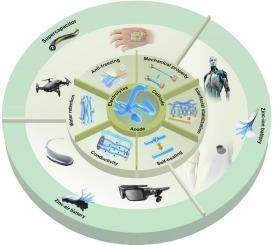Textile-integrated wearable energy devices: advances in hydrogel fibers for aqueous flexible energy storage
IF 22
1区 材料科学
Q1 MATERIALS SCIENCE, MULTIDISCIPLINARY
引用次数: 0
Abstract
Hydrogels have emerged as promising materials for aqueous flexible energy storage devices (AFESDs) due to their exceptional properties, including high shape adaptability, intrinsic conductivity, biocompatibility, elasticity, and responsiveness to external stimuli. Among various hydrogel formats, one-dimensional (1D) hydrogel fibers (HFs) have attracted growing interest owing to their superior mechanical flexibility, lightweight nature, and compact form factor, attributed to their highly aligned polymer chains. These advantages render HFs particularly well-suited for AFESDs compared to three-dimensional (3D) bulk gels and two-dimensional (2D) films. Despite their potential, systematic studies on HFs remain limited, with few comprehensive evaluations of their design, performance, and challenges. This review provides a critical overview of recent progress in HF-based materials, encompassing material design, synthesis strategies, fabrication methods, device architectures, and operational mechanisms. Emphasis is placed on their applications as electrodes and electrolytes in flexible capacitors and integrated AFESDs. This review also identifies current limitations and technical bottlenecks of HF-related AFESDs in terms of conductivity enhancement, mechanical performance balancing, interfacial stability, and environmental adaptability, offering insights into future research directions. By consolidating current knowledge, this work aims to support further development and broader recognition of HFs in the field of flexible energy storage.

纺织集成可穿戴能源装置:用于水柔性储能的水凝胶纤维的进展
由于其特殊的性能,包括高形状适应性、固有导电性、生物相容性、弹性和对外部刺激的响应性,水凝胶已成为水性柔性储能装置(afesd)的有前途的材料。在各种水凝胶形式中,一维(1D)水凝胶纤维(HFs)由于其高度排列的聚合物链具有优越的机械柔韧性、轻量化和紧凑的外形因素而引起了人们越来越多的兴趣。与三维(3D)散装凝胶和二维(2D)薄膜相比,这些优点使得高频凝胶特别适合于afesd。尽管它们具有潜力,但对高频燃料系统的系统研究仍然有限,对其设计、性能和挑战的综合评估很少。本文综述了高频基材料的最新进展,包括材料设计、合成策略、制造方法、器件架构和操作机制。重点是它们在柔性电容器和集成afesd中作为电极和电解质的应用。本文还从导电性增强、机械性能平衡、界面稳定性和环境适应性等方面确定了hf相关afesd目前的局限性和技术瓶颈,并为未来的研究方向提供了见解。通过巩固现有的知识,这项工作旨在支持柔性储能领域的氢能的进一步发展和更广泛的认识。
本文章由计算机程序翻译,如有差异,请以英文原文为准。
求助全文
约1分钟内获得全文
求助全文
来源期刊

Materials Today
工程技术-材料科学:综合
CiteScore
36.30
自引率
1.20%
发文量
237
审稿时长
23 days
期刊介绍:
Materials Today is the leading journal in the Materials Today family, focusing on the latest and most impactful work in the materials science community. With a reputation for excellence in news and reviews, the journal has now expanded its coverage to include original research and aims to be at the forefront of the field.
We welcome comprehensive articles, short communications, and review articles from established leaders in the rapidly evolving fields of materials science and related disciplines. We strive to provide authors with rigorous peer review, fast publication, and maximum exposure for their work. While we only accept the most significant manuscripts, our speedy evaluation process ensures that there are no unnecessary publication delays.
 求助内容:
求助内容: 应助结果提醒方式:
应助结果提醒方式:


